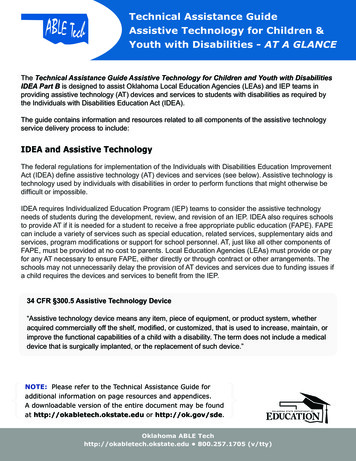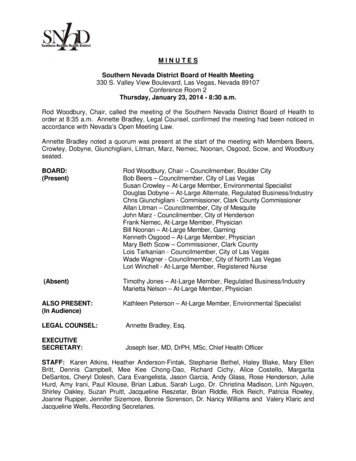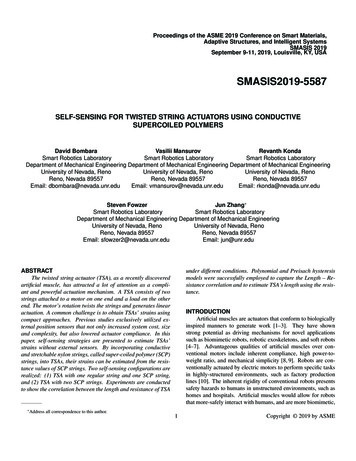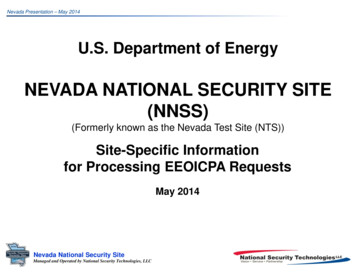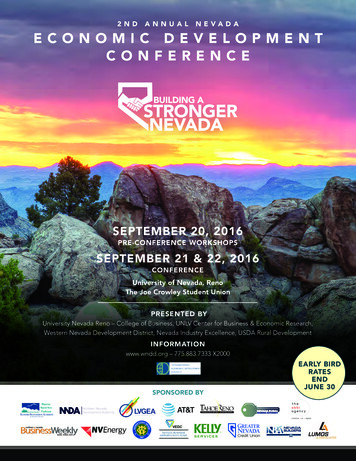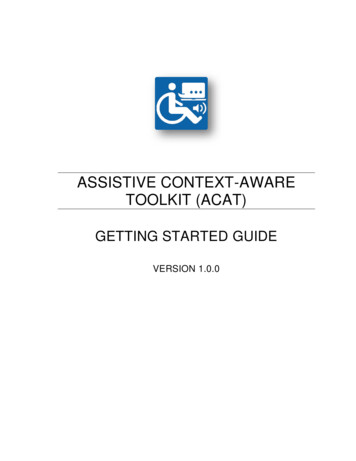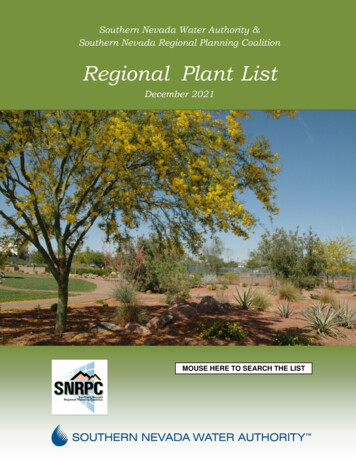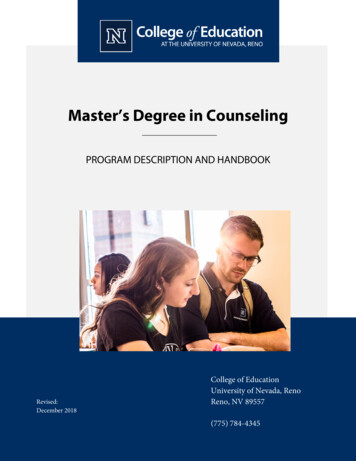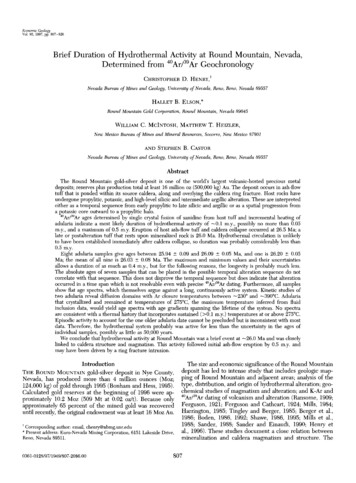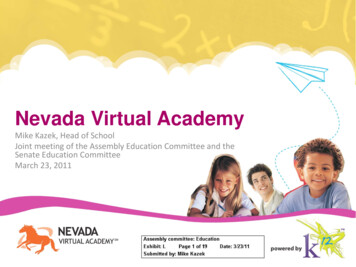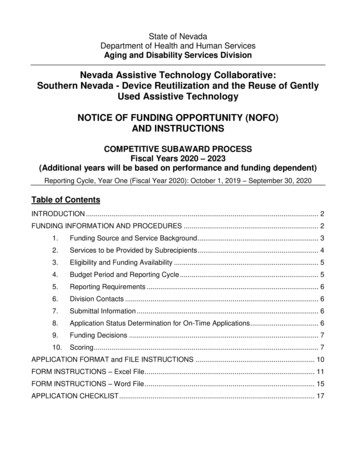
Transcription
State of NevadaDepartment of Health and Human ServicesAging and Disability Services DivisionNevada Assistive Technology Collaborative:Southern Nevada - Device Reutilization and the Reuse of GentlyUsed Assistive TechnologyNOTICE OF FUNDING OPPORTUNITY (NOFO)AND INSTRUCTIONSCOMPETITIVE SUBAWARD PROCESSFiscal Years 2020 – 2023(Additional years will be based on performance and funding dependent)Reporting Cycle, Year One (Fiscal Year 2020): October 1, 2019 – September 30, 2020Table of ContentsINTRODUCTION . 2FUNDING INFORMATION AND PROCEDURES . 21.Funding Source and Service Background . 32.Services to be Provided by Subrecipients . 43.Eligibility and Funding Availability . 54.Budget Period and Reporting Cycle . 55.Reporting Requirements . 66.Division Contacts . 67.Submittal Information . 68.Application Status Determination for On-Time Applications . 69.Funding Decisions . 710.Scoring . 7APPLICATION FORMAT and FILE INSTRUCTIONS . 10FORM INSTRUCTIONS – Excel File . 11FORM INSTRUCTIONS – Word File . 15APPLICATION CHECKLIST . 17
INTRODUCTIONThe Aging and Disability Services Division (ADSD) is seeking partner organizations to provideAssistive Technology services to individuals with disabilities as part of the Nevada AssistiveTechnology Collaborative. The programs will be funded through subawards consisting offederal funding. This Notice of Funding Opportunity (NOFO) establishes the requirements anapplicant must meet to be considered for funding.This NOFO and its corresponding application materials were posted on the Division’s websiteand emailed to current subrecipients and other interested parties. The materials are availablefor download at: http://adsd.nv.gov/Programs/Grant/Notices of Funding Opportunities/.FUNDING INFORMATION AND PROCEDURESNote: The terms “Division” and “ADSD” will be used interchangeably in reference to theAging and Disability Services Division throughout these instructions and the application.***A mandatory applicant orientation webinar will be held Wednesday, August 21, 2019.All interested applicants must attend this session.***DATEAugust 21, 2019TIME10:00 AMWEBINAR/TELECONFERENCE INFORMATIONhttp://webmeeting.att.comMeeting Number: 888-557-8511Access Code: 8605092Log into the webinar using the link provided.Enter the meeting number (no dashes), accesscode, your name, and email address to join thewebinar.For audio, dial the meeting number from yourtelephone and enter the access code.Before completing the application, thoroughly read this instruction packet and thedocuments outlined below. These documents outline subrecipient compliance requirements. General Service Specifications provide program standards for all funded programs,unless noted as exempt in the Notification of Subaward (NOSA). The Nevada AssistiveTechnology Collaborative Service Specifications outline baseline standards forcompliance for the specified service. The Division has final authority over content.Service Specifications are evolving documents and are available ments/. Program Policies as well are Annual Progress Report Instructions are availablewith the NOFO documents athttp://adsd.nv.gov/Programs/Grant/Notices of Funding Opportunities/. Additionally, asample of Goals and Objectives are provided within these instructions and theADSD Competitive Subaward, Application Instructions: FY20 NATC Services (South, Reuse)2 of 17
application. The FFY20 Goals and Objectives are also available at the above link forapplicants’ reference 1.Requirements and Procedures for Grant Programs (RPGPs) are statements ofADSD policy that ensure fiscal compliance with statutes, regulations and/or rules.Subrecipients must follow the RPGPs, and pending subsequent regulations, wheneverthe particular regulation applies to their funded program. The ADSD Requirements andProcedures for Grant Programs are available ent/Programs/Grant/FiscalRequirements.pdf.Funding Source and Service BackgroundThe NATC program services are funded through the Assistive Technology Act of 1998,As Amended under the Workforce Innovation and Opportunity Act (WIOA) P.L. 113-128.BackgroundThe creation of the Assistive Technology Act provided the State of Nevada with grantfunds to establish programs and services within the state. The Nevada AssistiveTechnology Collaborative (NATC) is Nevada’ AT Act program. Nevada chose toprovide services through collaborations with organizations that shared in the purpose ofthe AT.Purpose:To improve the provision of Assistive Technology (AT) to individuals with disabilitiesthrough a comprehensive statewide continuum of integrated activities, for individualswith disabilities of all ages, that are designed to: increase the availability of, funding for, access to, provision of, and training about ATdevices and AT services; increase the ability of individuals with disabilities of all ages to secure and maintainpossession of AT devices as such individuals make the transition between servicesoffered by educational or human service agencies or between settings of daily living(for example, between home and work); increase the capacity of public agencies and private entities to provide and pay forAT devices and AT services on a statewide basis for individuals with disabilities of allages; increase the involvement of individuals with disabilities and, if appropriate, theirfamily members, guardians, advocates, and authorized representatives, in decisionsrelated to the provision of AT devices and AT services; increase and promote coordination among State agencies, between State and localagencies, among local agencies, and between State and local agencies and privateentities;ADSD Competitive Subaward, Application Instructions: FY20 NATC Services (South, Reuse)3 of 17
increase the awareness and facilitate the change of laws, regulations, policies,practices, procedures, and organizational structures, that facilitate the availability orprovision of AT devices and AT services; and increase awareness and knowledge of the benefits of AT devices and AT servicesamong individuals with disabilities and their families, older individuals and theirfamilies, and the general population.Program services are provided statewide through community partners that possess boththe expertise and structure necessary to provide the services. Services are splitbetween northern and southern regions to ensure coverage throughout the stateefficiently. The northern region includes Carson, Churchill, Douglas, Elko, Eureka,Humboldt, Lander, Lyon, Mineral, Pershing, Storey, Washoe, and White Pine. Thesouthern region includes Esmeralda, Nye, Lincoln, and Clark.Services are provided based on the philosophy that (1) disability is a natural part of thehuman experience and in no way diminishes the right of individuals to liveindependently, enjoy self-determination, make choices, contribute to society andexperience full integration and inclusion in American society; and (2) services mustassure that people with disabilities, and their families, have access to culturallycompetent services, supports and other assistance and opportunities which promoteindependence, productivity and inclusion.2.Services to be Provided by SubrecipientsUnder this Notice of Funding Opportunity (NOFO), the selected subrecipient(s) mustprovide the following services described. The NATC’s goal is to establish a communitypartner that will create and maintain a significant AT reutilization program in southernNevada. Such a program will require a community partner that is committed to seekingadditional resources to establish a sustainable model. Such a program would includeAT for personal mobility such as wheelchairs, scooters, and power mobility devices aswell as AT for Self-care such as shower stools, shower chairs, shower transfer benches,and commodes. The NATC has equipment that could be utilized for the sanitation ofdonated AT as well as tools for repair.Device Reutilization program would consist of the soliciting and accepting of gentlyused AT for the purpose of making it available for other people in need. Program canalso include a Device Exchange option, but the NATC could not support a programproviding exchanges only.AT Device refurbish/repair and reassignment and/or open-ended device loan activitiesare those in which devices are accepted (usually by donation) into an inventory aresanitized and refurbished as needed, and then reassigned to a new owner (by sale orgive away) or placed with a new user via open-ended loan. The program would make itavailable for consumers if the AT is appropriate for their needs after ensuring it hasbeen sanitized, refurbished or repaired, if necessary. A program could also provide ATthat has been purchased if the community partner has a funding source outside of theAT Act and NATC to obtain the AT. Device exchange activities are those in whichdevices are listed in a “want ad” type posting, and consumers can contact and arrangeADSD Competitive Subaward, Application Instructions: FY20 NATC Services (South, Reuse)4 of 17
to obtain the device (either by purchasing it or obtaining it for free) from the currentowner. Exchange programs do not involve warehousing inventory and do not includerepair, sanitation or refurbishing of used devices.Public Awareness activities are designed to reach large numbers of people, includingactivities such as public service announcements, radio talk shows and news reports,newspaper stories and columns, newsletters, brochures, public forums and socialmedia.3.Eligibility and Funding AvailabilityPublic and private, nonprofit organizations can apply if interested in providing servicesoutlined in this NOFO.Available funding is allocated for southern Nevada 40,000 to provide a DeviceReutilization program. A program utilizing this funding could allocate a maximum of 5,000 towards public awareness which should be described if intended.Participation requires flexibility to accommodate opportunities and needs throughout thestate. Community partners would establish and maintain a close working relationshipwith the NATC to ensure services are meeting expectations. Prospective NATCpartners must have the expertise and structure necessary to provide the AT servicesand proposals should clearly provide evidence of those capabilities for each AT serviceincluded in their proposal. Prospective NATC partners must collect performancemeasure and survey data for all services provided. Program services may not be usedto supplant any agency’s responsibilities with regard to providing assistive technology topersons with disabilities.The final funding amount and number of subawards will be determined based on thenumber of responses received by ADSD, application scoring, regional allocations, andadministrator discretion.Funding is distributed as monthly or quarterly reimbursements. Subrecipients whorequire advance funding must thoroughly justify the need within the ApplicationQuestionnaire. ADSD may or may not accept the justification and could ask for furtherinformation before approving or denying the request. Advance payments are onlydistributed on a monthly basis and must be reconciled at the conclusion of each monthbefore additional funding will be released.4.Budget Period and Reporting CycleThis competitive process is for a yearly program with the potential of services over afour-year term, beginning October 1, 2019. The first year subaward budget andreporting period will be on a Federal Fiscal Year 2020 (FFY20), which is from October1, 2019, through September 30, 2020.Budgetary support for subrecipients beyond the first year will depend upon the overallavailability of funds, program performance, program reporting, and service prioritiesestablished by the Division. The completion of annual subaward continuationapplications is required in order to be considered for funding in FY21-23.ADSD Competitive Subaward, Application Instructions: FY20 NATC Services (South, Reuse)5 of 17
5.Reporting RequirementsAll funded programs must have the equipment and software required to report dataonline and scan, email and/or upload reports or other documents, as applicable perdirection from ADSD. ADSD uses email as its primary means of communication withapplicants and subrecipients. 6.All programs are required to report core data monthly.Monthly expenses must be tracked and reported to align with the AT service area.This would be provided with the monthly reimbursement.Request for Funds/Financial Reports are submitted monthly, quarterly, or asotherwise directed by ADSD.If funded, your assigned Program Specialist and Grants and Projects Specialist willprovide reporting instructions.The reporting schedule is posted at onal reporting may be required.Failure to comply with reporting requirements can place a subrecipient’s funding injeopardy.Aside from application scoring, the reporting history of existing programs willbe considered in funding recommendations and decisions.Division ContactsProgram Specific questions should be addressed to the IL Program Specialist:John RosenlundIL Program Specialistjrosenlund@adsd.nv.govTechnical assistance on the required forms can be directed to the Grant Manager:Kristi MartinSocial Services Manager Ikmartin@adsd.nv.gov7.Submittal Information Deadline: Wednesday, September 4, 2019.o Applications must be emailed to ADSDGrants@adsd.nv.gov andjrosenlund@adsd.nv.gov. Alternatively, existing subrecipients may also upload the file(s) to ADSD’sFTP server and send an email to the above email addresses to notifyADSD of the submission. 8.Failure to meet the application submission deadline will eliminate the applicationfrom consideration in this funding opportunity.Application Status Determination for On-Time Applications Each application will undergo an initial review for completeness and adherence toinstructions. Applications that do not meet all requirements will not be accepted forADSD Competitive Subaward, Application Instructions: FY20 NATC Services (South, Reuse)6 of 17
funding consideration. Applicants with rejected applications will receive writtennotification in September 2019.Rejected applicants may appeal this decision, in writing, to the ADSD Administratorin Carson City. The request for review must be received within five working daysfrom the notification of non-acceptance.The Administrator, or designee, will notify the applicant of the Administrator’sdecision, in writing, within ten working days of receiving the applicant’s appeal.The Administrator’s decision is final. There will be no additional appeal process.9.Funding Decisions After application acceptance, the NATC Director, Grants and Project Specialists andindependent reviewers will review all applications and make initial fundingrecommendations based on the scoring matrix on page 8. ADSD staff will review funding recommendations and scores with the Administrator.Reporting and compliance history of previous or current subrecipients will also bereviewed. The Administrator will consider all input prior to making final funding decisions. ADSD may negotiate with or seek additional information from applicants beforedecisions are made. The Administrator’s decision is final. Subaward announcements will tentatively be released in late May. Notices of Subaward (NOSAs) will be distributed in September, or as ADSDreceives requested subrecipient budget revisions, as applicable.10.ScoringApplications will be scored using the categories below, with a total maximum score of100 points. Applicants that follow the guidance below may better demonstrate theirability to successfully operate the program.Capacity, Experience, and Services (20 points) The applicant describes the organization’s capability to coordinate the programservices required.Staffing (30 points) The proposal describes sufficient experience of the administration andleadership. The proposal describes sufficient and reasonable staffing to ensure optimalservices and is it reflective in the budget. The organization currently has staff that are experienced in the provision of theprogram services as described. If not, the applicant described a viable plan tofind and hire appropriate staff. The organization describes existing staff or that they will hire staff knowledgeableabout an extensive range of AT including vision, hearing, speech communication,learning/cognition/developmental, mobility/seating/positioning, daily living,environmental adaptations, vehicle modifications/transportation,computers/related, and recreation/sports/leisure.Service Delivery (25 points)ADSD Competitive Subaward, Application Instructions: FY20 NATC Services (South, Reuse)7 of 17
The proposal describes how program services would be provided and thedescription is in line with the program model.The organization describes its capacity to provide outreach and publicawareness.The organization describes the ability to provide services throughout the requiredservices area.Program Budget (25 points) Personnel costs are reasonable to best ensure quality staff. Non-personnel operating costs reasonable and adequately justified.In the event an application is funded, the following will apply, in addition tothe documents listed on pages 2-3 (please keep this information for futurereference):1.Notice of Subaward (NOSA)The Notice of Subaward will be placed on ADSD’s FTP server if the successfulapplicant is an existing subrecipient. If the successful applicant does not currentlyreceive ADSD funding, or does not have access to the FTP server, the NOSA will beemailed. In each instance, a detailed email will be sent to the individual listed as theSubrecipient Contact on the Applicant Information page of the application (Excel file) tonotify the applicant of awarded funding. It is very important to read all documentscarefully, follow all instructions and comply with all special conditions (ifapplicable). An authorized representative of the subrecipient must fill-in, sign andreturn the NOSA documents to the assigned ADSD Grants and Projects Specialist(GPS), as listed in the email. ADSD must have on file a letter authorizing thesigner if that person is not the head of the nonprofit board, for-profit agency orpublic entity, depending on the type of organization.Please note: If budget revisions are required, ADSD must receive those revisions beforea NOSA can be issued. The Program Specialist or assigned GPS will contact you torequest revisions.Funds will not be released until all special conditions have been satisfied and allrequired, signed documents have been returned and approved by ADSD.2.Request for Funds-Financial Reporting (RFR)The Request for Reimbursement (RFR) is utilized when funding is requested by asubrecipient. The RFR must be completed, submitted and approved in order to drawdown funds. Funds are distributed as monthly or quarterly reimbursements, unless thesubrecipient has been approved for monthly advance payments (see page 3). The RFRwill be distributed to funded programs with the NOSA. Programs must use the providedform. RFRs must be accompanied with the required level of back-up documentation.ADSD can supply sample RFR and back-up documentation templates to interestedapplicants, as requested (contact ADSD).3.Vendor NumberAll vendors doing business with the State of Nevada must have a vendor numberassigned by the State Controller's Office. Current subrecipients do not have to completeADSD Competitive Subaward, Application Instructions: FY20 NATC Services (South, Reuse)8 of 17
this form, but new subrecipients are required to complete a Vendor Registration Formbefore any invoices or subaward payments can be made. The Vendor Form must becompleted by the subrecipient and submitted directly to Vendor Services, and a copymust be sent to ADSD’s Fiscal Unit in Carson City. Vendor Forms are available athttp://controller.nv.gov/. Electronic vendor registration is also available.4.Change of AddressTo change the program's address, the subrecipient must submit a Vendor InformationUpdate and/or Additional Remittance Form to the State Controller's Office. This form issubmitted directly to Vendor Services with a copy to ADSD’s Fiscal Unit in Carson City.The Division must be notified of address changes to avoid any delay in receivingfunds. Vendor Forms are available at http://controller.nv.gov/. Ensure your RFR formhas the correct address for vendor payments listed under Subrecipient Address.5.Performance IndicatorsPerformance Indicators are not required as a state service. However, PerformanceMeasures are built into the reporting requirements. A program will have establishedGoals and Objectives and ongoing review of the reported services throughout thepartnership with the NATC.6.Program Assessment and Fiscal MonitoringPrograms will be assessed on, at least, a biennial basis, in order to evaluate fiscalaccountability, progress towards achieving program goals, objectives, projectedoutcomes, client satisfaction and adherence to the ADSD’s NOSA, IncorporatedDocuments, Service Specifications, RPGPs and other regulations, as applicable.Program assessment visits occur at the location of service delivery and/or thesubrecipient’s office and may include visits to clients’ homes to discuss their satisfactionwith the services and view services. Fiscal monitoring is conducted on each subawardafter the budget period has ended, or as otherwise deemed necessary. The monitoringmay occur at the subrecipient’s office, or as a desk audit, depending on the type andsize of the subaward.7.Technical AssistanceAll subrecipients will be assigned a Grants and Projects Specialist (GPS), who isavailable to provide assistance with aspects of subaward management. Fiscal Auditorsare available to address questions regarding fiscal matters. The IL Program Specialistwill provide service-specific technical assistance and program development, as well asfile reviews.ADSD Competitive Subaward, Application Instructions: FY20 NATC Services (South, Reuse)9 of 17
APPLICATION FORMAT and FILE INSTRUCTIONSApplication FormatThe application MUST conform to the following requirements in order to be considered forfunding: Applications must be computer-generated (no handwritten or typewriter-producedapplications). The application must be concise and no more than 40 pages (excluding attachments). Donot include cover sheets, cover letters, unsolicited attachments or application instructionpages, as they will be included in the page limit. Specific page limits are listed next to pagenames below. If no page limit is listed, the document is one (1) page. Applications are expected to be free of spelling and grammatical errors. Use black, 12-point Arial font in the application’s Word file. In the Excel file, use the pre-setfont settings. The application must be submitted on Division forms. The application must be the ADSDCompetitive Subaward Application – Nevada Assistive Technology Collaborative Servicesversion (as shown in the application’s footer). Submitted applications must be on white, 8 ½ x 11 size paper, assembled according to theinstructions on the Application Checklist on page 17 and saved as a PDF document.Applicants that are not able to submit one file may follow the instructions on the ApplicationChecklist to submit the application in sections.Application FilesThree (3) files are to be used when completing the subaward application. The submitted PDFapplication must have all elements of these files included:1. Microsoft Excel File: ADSD Subaward Application- NATC FFY20 Part 12. Microsoft Word File: ADSD Subaward Application- NATC FFY20 Part 23. PDF File: DHHS Subrecipient Questionnaire Additionally, applicants must submit attachments as request within the ApplicationChecklist on page 17. Attachments are categorized by “mandatory,” “optional” or “ifapplicable.”The Excel file contains the following forms, in order: Applicant Information Budget Narrative, 8-page limit Budget SummaryTo access each form in Excel, click on the corresponding tab at the bottom of the page/workbook as shown here:ADSD Competitive Subaward, Application Instructions: FY20 NATC Services (South, Reuse)10 of 17
If you do not see the tabs at the bottom of the page, maximize the screenby clicking the button on the right side of the screen, as shown here:PLEASE NOTE: Do not utilize multiple copies of the Excel file to createyour application; there are formulas that carry from page-to-page. For bestresults, complete each tab of the workbook in order. Additionally, do notpaste information from past applications, as it might cause problems with the formulas. Thiswill ensure that invalid error messages are not shown on the application and linked boxes willhave a value.The Word file contains the following forms, in order: Project Narrative, 15-page limitProvider Requirements, 3-page limitGoals and Objectives, 3-page limitOrganizational Standards and Applicant Questionnaire, 3-page limitThe Subrecipient Questionnaire (PDF file) is pre-set at 6 pages. Provide an answer to eachquestion.Please contact ADSD if you have questions regarding a form, or if the information below forthe Excel and Word files does not answer your question.FORM INSTRUCTIONS – Excel FileAPPLICANT INFORMATIONBoxInstructions#1If the agency is not currently funded by ADSD for the proposed service, choose “NewApplicant or Type of Service.” If ADSD is currently funding the service, choose “CurrentlyFunded ADSD Subaward” and enter the agency’s FY19 subaward number for thatservice, which can be located on the FY19 NOSA.2No action required. The amount requested will auto-fill once the Budget Narrative iscomplete.3Select the agency’s organization type.4Enter Subrecipient and Program information, as requested on the form. Complete bothsections. Subrecipients are entities that are responsible for the funds awarded. Additionalinformation on Subrecipients (grantees) is in RPGPs. Programs are entities that provideservice delivery under the subaward. The subrecipient contact and program director mustnot be the same person for accountability purposes. For non-profit organizations, theSubrecipient contact must be the President of the Board of Directors.Enter the agency’s Employer Identification Number (EIN) or Federal Tax IdentificationNumber.Enter the agency’s Data Universal Numbering System (DUNS) Number. All DUNSnumbers are 9 digits. To request, look-up or make changes to a DUNS number, go toADSD Competitive Subaward, Application Instructions: FY20 NATC Services (South, Reuse)11 of 17
567891011http://fedgov.dnb.com/webform.No action required. The funding source has been pre-filled.Choose the NATC Services/NOFO for which your agency is applying.List the program’s service area(s) for the proposed service, by County.No action required. The funding source has been pre-filled.No action necessary. These subawards are categorical.No action required. The services have been pre-filled.Read the statement. Enter the name and title of the agency’s authorized representative.Once the authorized representative has reviewed the completed application package,he/she will sign and date the original Applicant Information form. By signing the forms,the representative is stating that he/she has approval from the Subrecipient to sign theforms and verified accuracy of the information within the entire application. ADSD musthave on file an official letter authorizing the signer if that person is not the head of thenonprofit board, for-profit agency or public entity, depending on the type of organization.BUDGET NARRATIVEThe applicant name, subaward and service type will auto-fill from information entered on theApplicant Information page.Describe program expenses requested from ADSD in the budget categories included in theBudget Narrative using the descriptions below as a guide to describe each category ofexpense. Be sure to provide a detailed response, explain how each expense is related to theproposed project and identify any one-time costs. Provide calculations where requested andfollow the examples. Utilize the RPGPs for rules and regulations on allowable expenses.THIS TAB IS NOT PROTECTED. Do not delete formulas. Ensure text in each row is visible;expand rows as needed (go to numbered rows on the left side of worksheet and drag thebottom line of the row down when you see your cursor change to, or right click on the rownumber and choose Row Height to enter a height). Each section has additional rows that youmay unhide to utilize. Contact ADSD if you need assistance.PERSONNE
State of Nevada Department of Health and Human Services Aging and Disability Services Division Nevada Assistive Technology Collaborative: Southern Nevada - Device Reutilization and the Reuse of Gently
